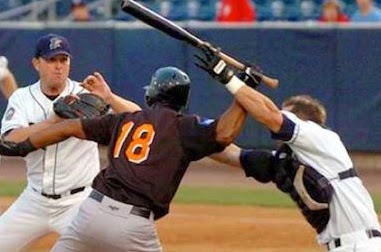Andrew
Robert Rector v. Major League Baseball Advanced Media, ESPN New
York
Supreme
Court of the State of New York, County of The Bronx, No. 303630 (2014)
What Happened?
Andrew
Robert Rector attended the April 13,
2014 game between the Red Sox and Yankees at Yankee Stadium. In the top of the fourth inning, Rector was
shown on the “Sunday Night Baseball” telecast while Dan Shulman and John Kruk
quipped about the fact that he appeared to be sleeping.
In
his complaint, Rector alleged that the comments made by Schulman and Kruk
amounted to an “unending verbal crusade against the napping plaintiff.” Specifically, Rector claimed that the
broadcast team used the words “stupor,” “fatty,” “unintelligent” and “stupid”
in describing him. He further asserted
they falsely claimed, among other things, that Rector was a “fatty cow that
needed two seats at all time[s] and represent (sic) symbol of failure” and “a
confused disgusted (sic) and socially bankrupt individual.”
Rector
was further angered that the scene was later posted to MLB.com and YouTube by Major
League Baseball Advanced Media under the title, “Tired Fan Naps in the Stands.”
As a
result, Rector brought a lawsuit against Major League Baseball Advanced Media,
ESPN New York, the New York Yankees, Dan Shulman and John Kruk seeking $10
million in damages for defamation of character and intentional infliction of
emotional distress claiming he suffered mental anguish, loss of future income
and loss of earning capacity as a result of the occurrence. He even went so far as to claim that
“insurance companies now consider me a high risk.”
The
commentary by Shulman and Kruk that pertained to Rector was made during a span
of less than 90 seconds in which plaintiff was on camera for a total of 31
seconds.
The
actual exchange between Shulman and Kruk follows:
Shulman:
This guy’s oblivious to how good it is.
Join the millions of subscribers, maybe even this guy. Watch every out of market game live in true
HD on over 400 devices. Visit MLB.tv for
details.
Kruk: Sometimes you have to turn it off, get some
sleep. This is not the place you come to
sleep. Tell you what though, how
comfortable it that? Probably won’t have
any neck problems tomorrow.
Shulman: I mean, is that guy to his left his buddy,
who’s just letting him sleep, or is he here alone? What’s the deal with this guy?
Kruk: Maybe that’s his buddy and he likes him a lot
better when he’s asleep.
Shulman: I think the other guy’s really more concerned
with the food and the game.
Kruk: Chicken fingers are a special item at the
ballpark. Why share? Get ‘em while he’s asleep so he won’t ask for
one.
Shulman: We gotta see how long this guy’s out for.
Kruk: You don’t think he can sleep, it’s only the
fourth inning, you don’t think he can sleep through?
Shulman: Did he sleep through the [Carlos] Beltran
homer? I mean 45,000 people stand up and
cheer and he sleeps through.
Kruk: You think it’d be tough to, but he seemed
comfortable. It didn’t look like he just
started to sleep.
Shulman: Not a cousin, not a relative?
Kruk: No, I don’t think so, but you never
know. I mean, I didn’t get a good look
at him cause of the head tilt. But I mean physically he could be, yeah.
As
you can see, this portion of the broadcast did not appear to support Rector’s allegations.
In
response, the defendants filed a motion to dismiss, asking the court to toss
the case because plaintiff had not properly stated a cause of action. The defendants attached a copy of the entire broadcast
as an exhibit to the motion and argued that literally none of the allegations
made by plaintiff were contained in any exchange between Shulman and Kruk for
the entirely of the telecast.
Furthermore, the defense claimed that any comments made about Rector
were “loose, figurative or hyperbolic statements” and otherwise harmless.
Who
Won?
The
defendants prevailed. In her opinion
issued on August 17, 2015 ,
Judge Julia I. Rodriguez granted the defendants’ motions and dismissed the case
in its entirety.
Why?
The
court found that the recording of the telecast conclusively established “that
none of the defendants made any of the statements attributed to them in the
complaint.” Additionally, the court held
that the statements made by Shulman and Kruk were not defamatory or
actionable.
As
to the intentional infliction of emotional distress claims, plaintiff had to
prove that defendants’ conduct was “so outrageous of character, and so extreme
in degree, as to go beyond all possible bounds of decency, and to be regarded
as atrocious, and utterly intolerable in a civilized community.” Not surprisingly, the court held that nothing
attributed to the defendants rose to the level of extreme and outrageous
conduct.
As a
result, plaintiff’s entire case was dismissed as to all defendants.










